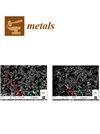Prediction of Failure Due to Fatigue of Wire Arc Additive Manufacturing-Manufactured Product
IF 2.5
3区 材料科学
Q3 MATERIALS SCIENCE, MULTIDISCIPLINARY
引用次数: 0
Abstract
Currently, the focus of production is shifting towards the use of innovative manufacturing techniques and away from traditional methods. Additive manufacturing technologies hold great promise for creating industrial products. The industry aims to enhance the reliability of individual components and structural elements, as well as the ability to accurately anticipate component failure, particularly due to fatigue. This paper explores the possibility of predicting component failure in parts produced using the WAAM (wire arc additive manufacturing) method by employing fractal dimension analysis. Additionally, the impact of manufacturing imperfections and various heat treatment processes on the fatigue resistance of 30CrMnSi steel has been investigated. Fatigue testing of samples and actual components fabricated via the WAAM process was conducted in this study. The destruction of the examined specimens and products was predicted by evaluating the fractal dimensions of micrographs acquired at different stages of fatigue testing. It has been established that technological defects are more dangerous in terms of fatigue failure than microstructural ones. The correctly selected mode of heat treatment for metal after electric arc welding allows for a more homogeneous microstructure with a near-complete absence of microstructural defects. A comparison of the fractal dimension method with other damage assessment methods shows that it has high accuracy in predicting part failure and is less labor-intensive than other methods.线弧增材制造--制成品的疲劳失效预测
目前,生产的重点正在从传统方法转向使用创新制造技术。快速成型制造技术在制造工业产品方面大有可为。该行业的目标是提高单个部件和结构元素的可靠性,以及准确预测部件故障(尤其是疲劳导致的故障)的能力。本文通过分形维度分析,探讨了预测使用线弧增材制造(WAAM)方法生产的部件失效的可能性。此外,还研究了制造缺陷和各种热处理工艺对 30CrMnSi 钢抗疲劳性的影响。本研究对通过 WAAM 工艺制造的样品和实际部件进行了疲劳测试。通过评估在疲劳测试不同阶段获得的显微照片的分形尺寸,预测了受检试样和产品的破坏情况。研究表明,就疲劳破坏而言,技术缺陷比微观结构缺陷更危险。正确选择电弧焊接后金属的热处理模式,可使微观结构更加均匀,几乎完全没有微观结构缺陷。分形维度法与其他损伤评估方法的比较表明,它在预测零件失效方面具有很高的准确性,而且与其他方法相比耗费的人力更少。
本文章由计算机程序翻译,如有差异,请以英文原文为准。
求助全文
约1分钟内获得全文
求助全文
来源期刊

Metals
MATERIALS SCIENCE, MULTIDISCIPLINARY-METALLURGY & METALLURGICAL ENGINEERING
CiteScore
4.90
自引率
13.80%
发文量
1832
审稿时长
1.5 months
期刊介绍:
Metals (ISSN 2075-4701) is an open access journal of related scientific research and technology development. It publishes reviews, regular research papers (articles) and short communications. Our aim is to encourage scientists to publish their experimental and theoretical results in as much detail as possible. Therefore, there is no restriction on the length of the papers. The full experimental details must be provided so that the results can be reproduced. Metals provides a forum for publishing papers which advance the in-depth understanding of the relationship between the structure, the properties or the functions of all kinds of metals.
 求助内容:
求助内容: 应助结果提醒方式:
应助结果提醒方式:


